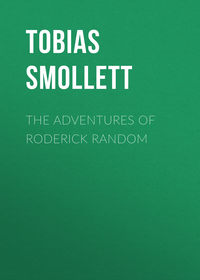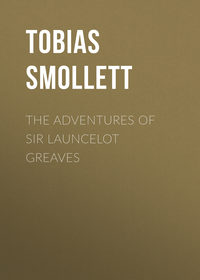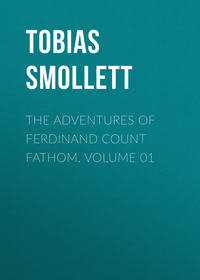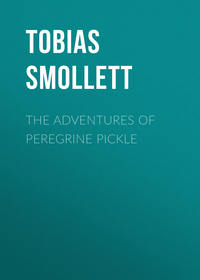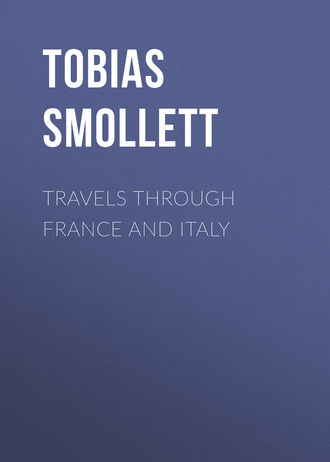 полная версия
полная версияПолная версия
Travels through France and Italy
LETTER XXX
NICE, February 28, 1765.DEAR SIR,—Nothing can be more agreeable to the eyes of a stranger, especially in the heats of summer, than the great number of public fountains that appear in every part of Rome, embellished with all the ornaments of sculpture, and pouring forth prodigious quantities of cool, delicious water, brought in aqueducts from different lakes, rivers, and sources, at a considerable distance from the city. These works are the remains of the munificence and industry of the antient Romans, who were extremely delicate in the article of water: but, however, great applause is also due to those beneficent popes who have been at the expence of restoring and repairing those noble channels of health, pleasure, and convenience. This great plenty of water, nevertheless, has not induced the Romans to be cleanly. Their streets, and even their palaces, are disgraced with filth. The noble Piazza Navona, is adorned with three or four fountains, one of which is perhaps the most magnificent in Europe, and all of them discharge vast streams of water: but, notwithstanding this provision, the piazza is almost as dirty, as West Smithfield, where the cattle are sold in London. The corridores, arcades, and even staircases of their most elegant palaces, are depositories of nastiness, and indeed in summer smell as strong as spirit of hartshorn. I have a great notion that their ancestors were not much more cleanly. If we consider that the city and suburbs of Rome, in the reign of Claudius, contained about seven millions of inhabitants, a number equal at least to the sum total of all the souls in England; that great part of antient Rome was allotted to temples, porticos, basilicae, theatres, thermae, circi, public and private walks and gardens, where very few, if any, of this great number lodged; that by far the greater part of those inhabitants were slaves and poor people, who did not enjoy the conveniencies of life; and that the use of linen was scarce known; we must naturally conclude they were strangely crouded together, and that in general they were a very frowzy generation. That they were crouded together appears from the height of their houses, which the poet Rutilius compared to towers made for scaling heaven. In order to remedy this inconvenience, Augustus Caesar published a decree, that for the future no houses should be built above seventy feet high, which, at a moderate computation, might make six stories. But what seems to prove, beyond all dispute, that the antient Romans were dirty creatures, are these two particulars. Vespasian laid a tax upon urine and ordure, on pretence of being at a great expence in clearing the streets from such nuisances; an imposition which amounted to about fourteen pence a year for every individual; and when Heliogabalus ordered all the cobwebs of the city and suburbs to be collected, they were found to weigh ten thousand pounds. This was intended as a demonstration of the great number of inhabitants; but it was a proof of their dirt, rather than of their populosity. I might likewise add, the delicate custom of taking vomits at each other's houses, when they were invited to dinner, or supper, that they might prepare their stomachs for gormandizing; a beastly proof of their nastiness as well as gluttony. Horace, in his description of the banquet of Nasiedenus, says, when the canopy, under which they sat, fell down, it brought along with it as much dirt as is raised by a hard gale of wind in dry weather.
—trahentia pulveris atri,Quantum non aquilo Campanis excitat agris.Such clouds of dust revolving in its trainAs Boreas whirls along the level plain.I might observe, that the streets were often encumbered with the putrefying carcasses of criminals, who had been dragged through them by the heels, and precipitated from the Scalae Gemoniae, or Tarpeian rock, before they were thrown into the Tyber, which was the general receptacle of the cloaca maxima and all the filth of Rome: besides, the bodies of all those who made away with themselves, without sufficient cause; of such as were condemned for sacrilege, or killed by thunder, were left unburned and unburied, to rot above ground.
I believe the moderns retain more of the customs of antient Romans, than is generally imagined. When I first saw the infants at the enfans trouves in Paris, so swathed with bandages, that the very sight of them made my eyes water, I little dreamed, that the prescription of the antients could be pleaded for this custom, equally shocking and absurd: but in the Capitol at Rome, I met with the antique statue of a child swaddled exactly in the same manner; rolled up like an Aegyptian mummy from the feet. The circulation of the blood, in such a case, must be obstructed on the whole surface of the body; and nothing be at liberty but the head, which is the only part of the child that ought to be confined. Is it not surprising that common sense should not point out, even to the most ignorant, that those accursed bandages must heat the tender infant into a fever; must hinder the action of the muscles, and the play of the joints, so necessary to health and nutrition; and that while the refluent blood is obstructed in the veins, which run on the surface of the body, the arteries, which lie deep, without the reach of compression, are continually pouring their contents into the head, where the blood meets with no resistance? The vessels of the brain are naturally lax, and the very sutures of the skull are yet unclosed. What are the consequences of this cruel swaddling? the limbs are wasted; the joints grow rickety; the brain is compressed, and a hydrocephalus, with a great head and sore eyes, ensues. I take this abominable practice to be one great cause of the bandy legs, diminutive bodies, and large heads, so frequent in the south of France, and in Italy.
I was no less surprised to find the modern fashion of curling the hair, borrowed in a great measure from the coxcombs and coquettes of antiquity. I saw a bust of Nero in the gallery at Florence, the hair represented in rows of buckles, like that of a French petit-maitre, conformable to the picture drawn of him by Suetonius. Circa cultum adeo pudendum, ut coman semper in gradus formatam peregrinatione achaica, etiam pene verticem sumpserit, So very finical in his dress, that he wore his hair in the Greek fashion, curled in rows almost to the crown of his head. I was very sorry however to find that this foppery came from Greece. As for Otho, he wore a galericulum, or tour, on account of thin hair, propter raritatem capillorum. He had no right to imitate the example of Julius Caesar, who concealed his bald head with a wreath of laurel. But there is a bust in the Capitol of Julia Pia, the second wife of Septimius Severus, with a moveable peruke, dressed exactly in the fashionable mode, with this difference, that there is no part of it frizzled; nor is there any appearance of pomatum and powder. These improvements the beau-monde have borrowed from the natives of the Cape of Good Hope.
Modern Rome does not cover more than one-third of the space within the walls; and those parts that were most frequented of old are now intirely abandoned. From the Capitol to the Coliseo, including the Forum Romanum and Boarium, there is nothing intire but one or two churches, built with the fragments of ancient edifices. You descend from the Capitol between the remaining pillars of two temples, the pedestals and part of the shafts sunk in the rubbish: then passing through the triumphal arch of Septimius Severus, you proceed along the foot of Mons Palatinus, which stands on your right hand, quite covered with the ruins of the antient palace belonging to the Roman emperors, and at the foot of it, there are some beautiful detached pillars still standing. On the left you see the remains of the Templum Pacis, which seems to have been the largest and most magnificent of all the temples in Rome. It was built and dedicated by the emperor Vespasian, who brought into it all the treasure and precious vessels which he found in the temple of Jerusalem. The columns of the portico he removed from Nero's golden house, which he levelled with the ground. This temple was likewise famous for its library, mentioned by Aulus Gellius, Further on, is the arch of Constantine on the right, a most noble piece of architecture, almost entire; with the remains of the Meta Sudans before it; and fronting you, the noble ruins of that vast amphitheatre, called the Colossaeum, now Coliseo, which has been dismantled and dilapidated by the Gothic popes and princes of modern Rome, to build and adorn their paultry palaces. Behind the amphitheatre were the thermae of the same emperor Titus Vespasian. In the same quarter was the Circus Maximus; and the whole space from hence on both sides, to the walls of Rome, comprehending above twice as much ground as the modern city, is almost covered with the monuments of antiquity. I suppose there is more concealed below ground than appears above. The miserable houses, and even garden-walls of the peasants in this district, are built with these precious materials. I mean shafts and capitals of marble columns, heads, arms, legs, and mutilated trunks of statues. What pity it is that among all the remains of antiquity, at Rome, there is not one lodging-house remaining. I should be glad to know how the senators of Rome were lodged. I want to be better informed touching the cava aedium, the focus, the ara deorum penatum, the conclavia, triclinia, and caenationes; the atria where the women resided, and employed themselves in the woolen manufacture; the praetoria, which were so spacious as to become a nuisance in the reign of Augustus; and the Xysta, which were shady walks between two porticos, where the men exercised themselves in the winter. I am disgusted by the modern taste of architecture, though I am no judge of the art. The churches and palaces of these days are crowded with pretty ornaments, which distract the eye, and by breaking the design into a variety of little parts, destroy the effect of the whole. Every door and window has its separate ornaments, its moulding, frize, cornice, and tympanum; then there is such an assemblage of useless festoons, pillars, pilasters, with their architraves, entablatures, and I know not what, that nothing great or uniform remains to fill the view; and we in vain look for that simplicity of grandeur, those large masses of light and shadow, and the inexpressible EUSUINOPTON, which characterise the edifices of the antients. A great edifice, to have its full effect, ought to be isole, or detached from all others, with a large space around it: but the palaces of Rome, and indeed of all the other cities of Italy, which I have seen, are so engaged among other mean houses, that their beauty and magnificence are in a great measure concealed. Even those which face open streets and piazzas are only clear in front. The other apartments are darkened by the vicinity of ordinary houses; and their views are confined by dirty and disagreeable objects. Within the court there is generally a noble colonnade all round, and an open corridore above, but the stairs are usually narrow, steep, and high, the want of sash-windows, the dullness of their small glass lozenges, the dusty brick floors, and the crimson hangings laced with gold, contribute to give a gloomy air to their apartments; I might add to these causes, a number of Pictures executed on melancholy subjects, antique mutilated statues, busts, basso relieves, urns, and sepulchral stones, with which their rooms are adorned. It must be owned, however, there are some exceptions to this general rule. The villa of cardinal Alexander Albani is light, gay, and airy; yet the rooms are too small, and too much decorated with carving and gilding, which is a kind of gingerbread work. The apartments of one of the princes Borghese are furnished in the English taste; and in the palazzo di colonna connestabile, there is a saloon, or gallery, which, for the proportions, lights, furniture, and ornaments, is the most noble, elegant, and agreeable apartment I ever saw.
It is diverting to hear all Italian expatiate upon the greatness of modern Rome. He will tell you there are above three hundred palaces in the city; that there is scarce a Roman prince, whose revenue does not exceed two hundred thousand crowns; and that Rome produces not only the most learned men, but also the most refined politicians in the universe. To one of them talking in this strain, I replied, that instead of three hundred palaces, the number did not exceed fourscore; that I had been informed, on good authority, there were not six individuals in Rome who had so much as forty thousand crowns a year, about ten thousand pounds sterling; and that to say their princes were so rich, and their politicians so refined, was, in effect, a severe satire upon them, for not employing their wealth and their talents for the advantage of their country. I asked why their cardinals and princes did not invite and encourage industrious people to settle and cultivate the Campania of Rome, which is a desert? why they did not raise a subscription to drain the marshes in the neighbourhood of the city, and thus meliorate the air, which is rendered extremely unwholsome in the summer, by putrid exhalations from those morasses? I demanded of him, why they did not contribute their wealth, and exert their political refinements, in augmenting their forces by sea and land, for the defence of their country, introducing commerce and manufactures, and in giving some consequence to their state, which was no more than a mite in the political scale of Europe? I expressed a desire to know what became of all those sums of money, inasmuch as there was hardly any circulation of gold and silver in Rome, and the very bankers, on whom strangers have their credit, make interest to pay their tradesmen's bills with paper notes of the bank of Spirito Santo? And now I am upon this subject, it may not be amiss to observe that I was strangely misled by all the books consulted about the current coin of Italy. In Tuscany, and the Ecclesiastical State, one sees nothing but zequines in gold, and pieces of two paoli, one paolo, and half a paolo, in silver. Besides these, there is a copper coin at Rome, called bajocco and mezzo bajocco. Ten bajocchi make a paolo: ten paoli make a scudo, which is an imaginary piece: two scudi make a zequine; and a French loui'dore is worth two zequines and two paoli.
Rome has nothing to fear from the catholic powers, who respect it with a superstitious veneration as the metropolitan seat of their religion: but the popes will do well to avoid misunderstandings with the maritime protestant states, especially the English, who being masters of the Mediterranean, and in possession of Minorca, have it in their power at all times, to land a body of troops within four leagues of Rome, and to take the city, without opposition. Rome is surrounded with an old wall, but altogether incapable of defence. Or if it was, the circuit of the walls is so extensive, that it would require a garrison of twenty thousand men. The only appearance of a fortification in this city, is the castle of St. Angelo, situated on the further bank of the Tyber, to which there is access by a handsome bridge: but this castle, which was formerly the moles Adriani, could not hold out half a day against a battery of ten pieces of cannon properly directed. It was an expedient left to the invention of the modern Romans, to convert an ancient tomb into a citadel. It could only serve as a temporary retreat for the pope in times of popular commotion, and on other sudden emergencies; as it happened in the case of pope Clement VII. when the troops of the emperor took the city by assault; and this only, while he resided at the Vatican, from whence there is a covered gallery continued to the castle: it can never serve this purpose again, while the pontiff lives on Monte Cavallo, which is at the other end of the city. The castle of St. Angelo, howsoever ridiculous as a fortress, appears respectable as a noble monument of antiquity, and though standing in a low situation, is one of the first objects that strike the eye of a stranger approaching Rome. On the opposite side of the river, are the wretched remains of the Mausoleum Augusti, which was still more magnificent. Part of the walls is standing, and the terraces are converted into garden-ground. In viewing these ruins, I remembered Virgil's pathetic description of Marcellus, who was here intombed.
Quantos ille virum, magnum mavortis ad urbem.Campus aget gemitus, vel que Tyberine, videbisFunera, cum tumulum, preter labere recentem.Along his Banks what Groans shall Tyber hear,When the fresh tomb and funeral pomp appear!The beautiful poem of Ovid de Consolatione ad Liviam, written after the ashes of Augustus and his nephew Marcellus, of Germanicus, Agrippa, and Drusus, were deposited in this mausoleum, concludes with these lines, which are extremely tender:
Claudite jam Parcae nimium reserata sepulchra;Claudite, plus justo, jam domus ista patet!Ah! shut these yawning Tombs, ye sister Fates!Too long unclos'd have stood those dreary Gates!What the author said of the monument, you will be tempted to say of this letter, which I shall therefore close in the old stile, assuring you that I ever am,—Yours most affectionately.
LETTER XXXI
NICE, March 5, 1765DEAR SIR,—In my last I gave you my opinion freely of the modern palaces of Italy. I shall now hazard my thoughts upon the gardens of this country, which the inhabitants extol with all the hyperboles of admiration and applause. I must acknowledge however, I have not seen the famous villas at Frascati and Tivoli, which are celebrated for their gardens and waterworks. I intended to visit these places; but was prevented by an unexpected change of weather, which deterred me from going to the country. On the last day of September the mountains of Palestrina were covered with snow; and the air became so cold at Rome, that I was forced to put on my winter cloaths. This objection continued, till I found it necessary to set out on my return to Florence. But I have seen the gardens of the Poggio Imperiale, and the Palazzo de Pitti at Florence, and those of the Vatican, of the pope's palace on Monte Cavallo, of the Villa Ludovisia, Medicea, and Pinciana, at Rome; so that I think I have some right to judge of the Italian taste in gardening. Among those I have mentioned, that of the Villa Pinciana, is the most remarkable, and the most extensive, including a space of three miles in circuit, hard by the walls of Rome, containing a variety of situations high and low, which favour all the natural embellishments one would expect to meet with in a garden, and exhibit a diversity of noble views of the city and adjacent country.
In a fine extensive garden or park, an Englishman expects to see a number of groves and glades, intermixed with an agreeable negligence, which seems to be the effect of nature and accident. He looks for shady walks encrusted with gravel; for open lawns covered with verdure as smooth as velvet, but much more lively and agreeable; for ponds, canals, basins, cascades, and running streams of water; for clumps of trees, woods, and wildernesses, cut into delightful alleys, perfumed with honeysuckle and sweet-briar, and resounding with the mingled melody of all the singing birds of heaven: he looks for plats of flowers in different parts to refresh the sense, and please the fancy; for arbours, grottos, hermitages, temples, and alcoves, to shelter him from the sun, and afford him means of contemplation and repose; and he expects to find the hedges, groves, and walks, and lawns kept with the utmost order and propriety. He who loves the beauties of simple nature, and the charms of neatness will seek for them in vain amidst the groves of Italy. In the garden of the Villa Pinciana, there is a plantation of four hundred pines, which the Italians view with rapture and admiration: there is likewise a long walk, of trees extending from the garden-gate to the palace; and plenty of shade, with alleys and hedges in different parts of the ground: but the groves are neglected; the walks are laid with nothing but common mould or sand, black and dusty; the hedges are tall, thin and shabby; the trees stunted; the open ground, brown and parched, has scarce any appearance of verdure. The flat, regular alleys of evergreens are cut into fantastic figures; the flower gardens embellished with thin cyphers and flourished figures in box, while the flowers grow in rows of earthen-pots, and the ground appears as dusky as if it was covered with the cinders of a blacksmith's forge. The water, of which there is great plenty, instead of being collected in large pieces, or conveyed in little rivulets and streams to refresh the thirsty soil, or managed so as to form agreeable cascades, is squirted from fountains in different parts of the garden, through tubes little bigger than common glyster-pipes. It must be owned indeed that the fountains have their merit in the way of sculpture and architecture; and that here is a great number of statues which merit attention: but they serve only to encumber the ground, and destroy that effect of rural simplicity, which our gardens are designed to produce. In a word, here we see a variety of walks and groves and fountains, a wood of four hundred pines, a paddock with a few meagre deer, a flower-garden, an aviary, a grotto, and a fish-pond; and in spite of all these particulars, it is, in my opinion, a very contemptible garden, when compared to that of Stowe in Buckinghamshire, or even to those of Kensington and Richmond. The Italians understand, because they study, the excellencies of art; but they have no idea of the beauties of nature. This Villa Pinciana, which belongs to the Borghese family, would make a complete academy for painting and sculpture, especially for the study of antient marbles; for, exclusive of the statues and busts in the garden, and the vast collection in the different apartments, almost the whole outside of the house is covered with curious pieces in basso and alto relievo. The most masterly is that of Curtius on horseback, leaping into the gulph or opening of the earth, which is said to have closed on receiving this sacrifice. Among the exhibitions of art within the house, I was much struck with a Bacchus, and the death of Meleager, represented on an antient sepulchre. There is also an admirable statue of Silenus, with the infant Bacchus in his arms; a most beautiful gladiator; a curious Moor of black marble, with a shirt of white alabaster; a finely proportioned bull of black marble also, standing upon a table of alabaster; a black gipsey with a head, hands, and feet of brass; and the famous hermaphrodite, which vies with that of Florence: though the most curious circumstance of this article, is the mattrass executed and placed by Bernini, with such art and dexterity, that to the view, it rivals the softness of wool, and seems to retain the marks of pressure, according to the figure of the superincumbent statue. Let us likewise own, for the honour of the moderns, that the same artist has produced two fine statues, which we find among the ornaments of this villa, namely, a David with his sling in the attitude of throwing the stone at the giant Goliah; and a Daphne changing into laurel at the approach of Apollo. On the base of this figure, are the two following elegant lines, written by pope Urban VIII. in his younger years.
Quisquis amans sequitur fugitivae gaudia formae,Fronde manus implet, baccas vel carpit amaras.Who pants for fleeting Beauty, vain pursuit!Shall barren Leaves obtain, or bitter fruit.I ought not to forget two exquisite antique statues of Venus, the weeping slave, and the youth pulling a thorn out of his foot.
I do not pretend to give a methodical detail of the curiosities of Rome: they have been already described by different authors, who were much better qualified than I am for the talk: but you shall have what observations I made on the most remarkable objects, without method, just as they occur to my remembrance; and I protest the remarks are all my own: so that if they deserve any commendation, I claim all the merit; and if they are impertinent, I must be contented to bear all the blame.
The piazza of St. Peter's church is altogether sublime. The double colonnade on each side extending in a semi-circular sweep, the stupendous Aegyptian obelisk, the two fountains, the portico, and the admirable facade of the church, form such an assemblage of magnificent objects, as cannot fail to impress the mind with awe and admiration: but the church would have produced a still greater effect, had it been detached entirely from the buildings of the Vatican, It would then have been a master-piece of architecture, complete in all its parts, intire and perfect: whereas, at present, it is no more than a beautiful member attached to a vast undigested and irregular pile of building. As to the architecture of this famous temple, I shall say nothing; neither do I pretend to describe the internal ornaments. The great picture of Mosaic work, and that of St. Peter's bark tossed by the tempest, which appear over the gate of the church, though rude in comparison with modern pieces, are nevertheless great curiosities, when considered as the work of Giotto, who flourished in the beginning of the fourteenth century. His master was Cimabue, who learned painting and architecture of the Grecian artists, who came from Constantinople, and first revived these arts in Italy. But, to return to St. Peter's, I was not at all pleased with the famous statue of the dead Christ in his mother's lap, by Michael Angelo. The figure of Christ is as much emaciated, as if he had died of a consumption: besides, there is something indelicate, not to say indecent, in the attitude and design of a man's body, stark naked, lying upon the knees of a woman. Here are some good pictures, I should rather say copies of good pictures, done in Mosaic to great perfection; particularly a St. Sebastian by Domenichino, and Michael the Archangel, from a painting of Guido Rheni. I am extremely fond of all this artist's pieces. There is a tenderness and delicacy in his manner; and his figures are all exquisitely beautiful, though his expression is often erroneous, and his attitudes are always affected and unnatural. In this very piece the archangel has all the air of a French dancing-master; and I have seen a Madonna by the same hand, I think it is in the Palazzo di Barberini, in which, though the figures are enchanting, the Virgin is represented holding up the drapery of the infant, with the ridiculous affectation of a singer on the stage of our Italian opera. The Mosaic work, though brought to a wonderful degree of improvement, and admirably calculated for churches, the dampness of which is pernicious to the colours of the pallet, I will not yet compare to the productions of the pencil. The glassyness (if I may be allowed the expression) of the surface, throws, in my opinion, a false light on some parts of the picture; and when you approach it, the joinings of the pieces look like so many cracks on painted canvas. Besides, this method is extremely tedious and expensive. I went to see the artists at work, in a house that stands near the church, where I was much pleased with the ingenuity of the process; and not a little surprized at the great number of different colours and tints, which are kept in separate drawers, marked with numbers as far as seventeen thousand. For a single head done in Mosaic, they asked me fifty zequines. But to return to the church. The altar of St. Peter's choir, notwithstanding all the ornaments which have been lavished upon it, is no more than a heap of puerile finery, better adapted to an Indian pagod, than to a temple built upon the principles of the Greek architecture. The four colossal figures that support the chair, are both clumsy and disproportioned. The drapery of statues, whether in brass or stone, when thrown into large masses, appears hard and unpleasant to the eye and for that reason the antients always imitated wet linen, which exhibiting the shape of the limbs underneath, and hanging in a multiplicity of wet folds, gives an air of lightness, softness, and ductility to the whole.




